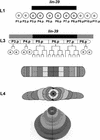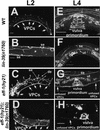LIN-39/Hox triggers cell division and represses EFF-1/fusogen-dependent vulval cell fusion
- PMID: 12502736
- PMCID: PMC187502
- DOI: 10.1101/gad.251202
LIN-39/Hox triggers cell division and represses EFF-1/fusogen-dependent vulval cell fusion
Abstract
General mechanisms by which Hox genes establish cell fates are known. However, a few Hox effectors mediating cell behaviors have been identified. Here we found the first effector of LIN-39/HoxD4/Dfd in Caenorhabditis elegans. In specific vulval precursor cells (VPCs), LIN-39 represses early and late expression of EFF-1, a membrane protein essential for cell fusion. Repression of eff-1 is also achieved by the activity of CEH-20/Exd/Pbx, a known cofactor of Hox proteins. Unfused VPCs in lin-39(-);eff-1(-) double mutants fail to divide but migrate, executing vulval fates. Thus, lin-39 is essential for inhibition of EFF-1-dependent cell fusion and stimulation of cell proliferation during vulva formation. Supplemental material is available at http://www.genesdev.org.
Figures




Similar articles
-
Cell fates and fusion in the C. elegans vulval primordium are regulated by the EGL-18 and ELT-6 GATA factors -- apparent direct targets of the LIN-39 Hox protein.Development. 2002 Nov;129(22):5171-80. doi: 10.1242/dev.129.22.5171. Development. 2002. PMID: 12399309
-
Transcriptional control of Notch signaling by a HOX and a PBX/EXD protein during vulval development in C. elegans.Dev Biol. 2007 Feb 15;302(2):661-9. doi: 10.1016/j.ydbio.2006.09.049. Epub 2006 Oct 4. Dev Biol. 2007. PMID: 17084835
-
The C. elegans hox gene lin-39 controls cell cycle progression during vulval development.Dev Biol. 2016 Oct 1;418(1):124-134. doi: 10.1016/j.ydbio.2016.07.018. Epub 2016 Jul 27. Dev Biol. 2016. PMID: 27475488
-
Cell fusion.WormBook. 2006 Jan 6:1-32. doi: 10.1895/wormbook.1.52.1. WormBook. 2006. PMID: 18050486 Free PMC article. Review.
-
Nematode development. Variations on a vulval theme.Curr Biol. 1994 Dec 1;4(12):1128-30. doi: 10.1016/s0960-9822(00)00254-2. Curr Biol. 1994. PMID: 7704579 Review.
Cited by
-
Genetic control of fusion pore expansion in the epidermis of Caenorhabditis elegans.Mol Biol Cell. 2007 Apr;18(4):1153-66. doi: 10.1091/mbc.e06-09-0855. Epub 2007 Jan 17. Mol Biol Cell. 2007. PMID: 17229888 Free PMC article.
-
Mechanisms of lineage specification in Caenorhabditis elegans.Genetics. 2023 Dec 6;225(4):iyad174. doi: 10.1093/genetics/iyad174. Genetics. 2023. PMID: 37847877 Free PMC article.
-
The transcription factor VAB-23 links vulval cell fate specification and morphogenesis.Worm. 2012 Jul 1;1(3):170-5. doi: 10.4161/worm.20382. Worm. 2012. PMID: 24058843 Free PMC article.
-
Control of vulval competence and centering in the nematode Oscheius sp. 1 CEW1.Genetics. 2003 Jan;163(1):133-46. doi: 10.1093/genetics/163.1.133. Genetics. 2003. PMID: 12586702 Free PMC article.
-
Variability in β-catenin pulse dynamics in a stochastic cell fate decision in C. elegans.Dev Biol. 2020 May 15;461(2):110-123. doi: 10.1016/j.ydbio.2020.02.004. Epub 2020 Feb 4. Dev Biol. 2020. PMID: 32032579 Free PMC article.
References
-
- Alper S, Kenyon C. REF-1, a protein with two bHLH domains, alters the pattern of cell fusion in C. elegans by regulating Hox protein activity. Development. 2001;128:1793–1804. - PubMed
-
- ————— The zinc finger protein REF-2 functions with the Hox genes to inhibit cell fusion in the ventral epidermis of C. elegans. Development. 2002;129:3335–3348. - PubMed
-
- Amthor H, Christ B, Weil M, Patel K. The importance of timing differentiation during limb muscle development. Curr Biol. 1998;8:642–652. - PubMed
-
- Ch'ng Q, Kenyon C. egl-27 generates anteroposterior patterns of cell fusion in C. elegans by regulating Hox gene expression and Hox protein function. Development. 1999;126:3303–3312. - PubMed
Publication types
MeSH terms
Substances
LinkOut - more resources
Full Text Sources
Other Literature Sources
